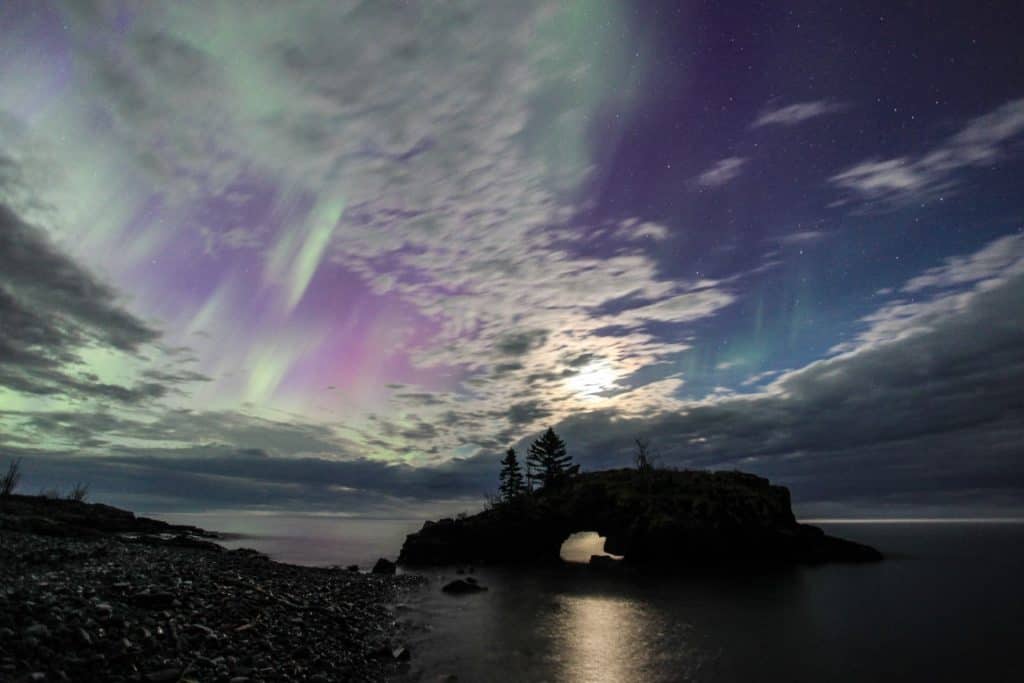
The county at the northeastern tip of Minnesota is encouraging visitors to find stars and northern lights this winter in its wild skies. Cook County includes significant portions of the Superior National Forest and the Boundary Waters Canoe Area Wilderness.
Visit Cook County has partnered with Grand Marais-based photographer Bryan Hansel to create an ad campaign and maps of routes to find good views of the dark skies. The effort was recently highlighted in this news segment by KSTP.
There is already a lot of interest in star-gazing and northern lights viewing, according to Kjersti Vick, marketing director with Visit Cook County.
“Anybody can feel that darkness and experience that dark and quiet that we have up here,” Vick told KSTP News. “I would say we get at least five phone calls a week minimum, plus another two dozen emails a week, people asking about star gazing. ‘Where can I see the Northern Lights?’ ‘What time can I see the Northern Lights?’ ‘Is there a chance I’m going to see the Northern Lights?’ So people are really excited about this.”
Visit Cook County offers eight tips for viewing the northern lights:
- Check the forecast. The best viewing is during clear nights with little to no moonlight.
- Stay up late. Night owls have the best chance of catching this incredible phenomenon. Best times to see them is often between 9pm – 4am.
- Bundle up. Bring blankets and a thermos of hot chocolate. Northern nights get chilly.
- Look to the North. Grab a compass and find a spot with a good view to the north, without hills or trees blocking your line of sight.
- Turn off lights. Artificial light will make it more difficult to see the Northern Lights. Be sure to turn off car lights, house lights, flashlight and keep your cell phone screen dim.
- Be patient. Part of their mystique is the unpredictability of occurrence. Catching a glimpse of the Northern Lights takes dedication, patience and a good friend to keep you company.
- Know what to look for. Aurora borealis appear in a broad spectrum of colors. Most typically seen is a faint green-yellow or white-grey display. However, purples and reds can also be seen.
- Tell a friend. When venturing into the woods to find that perfect spot, be sure to let someone know where you are going and when you expect to return. Also, letting someone else know the Northern Lights are out will increase your chance of them returning the favor in the future.

from The new world atlas of artificial night sky brightness
The Boundary Waters region has some of the lowest levels of light pollution in Minnesota — and the country. According to the tourism bureau, Cook County is the best place to see the Aurora Borealis in the lower 48 states. Explore a map of light pollution levels around the world here.
The International Dark Sky Association promotes places with exceptionally dark night skies, and offers resources for reducing light pollution. There are not yet any certified International Dark Sky Places in Minnesota, which require extensive community support.
The organization offers the following criteria for responsible outdoor lighting:
- Only be on when needed
- Only light the area that needs it
- Be no brighter than necessary
- Minimize blue light emissions
- Be fully shielded (pointing downward)
Eighty percent of the world’s population (and 99 percent of the people in the United States and Europe) live in areas affected by light pollution, according to a 2016 study. It not only impairs views of the natural night sky, but adversely affects the environment, public safety, energy consumption, and human health.

